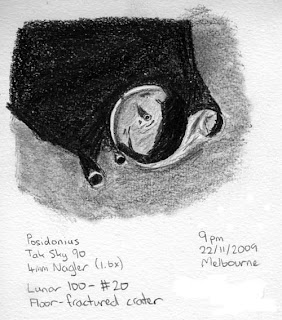We
had planned to go camping this weekend: take the scope out to some dark site, stay up really late, it'd be awesome! Yes, well, then we realised that it's a full moon this weekend. Great. Also, the weather forecast just got worse and worse.... So we decided to visit the parentals in Ballarat, because that is at least a bit darker than Melbourne, and if the weather was bad it wouldn't be a disaster.
So we came up yesterday, on a scorching afternoon - where were those thunderstorms? - in time to have dinner with some good friends of J's parents. As they were leaving (after there had been lightning, and a short but violent rain storm), the clouds had cleared somewhat so we dragged the telescope out to show them (and especially their two young kids) the moon - enormous and very bright - and Jupiter, which was a real highlight. Could only see two cloud bands, the brief time I looked, and at first it looked like there were only three moons visible. On closer inspection, the fourth was there, really close to Jupiter itself. Which at least one of the kids could definitely see and was very excited about.
The hard core aspect of this weekend was the setting of the alarm for 4am this morning. And that we actually got up when it went off. Admittedly, I hadn't slept that well because it was hot. We crept outside - trying very hard not to disturb other sleepers - and set Ptolemy up on the side away from the moon, which was only just disappearing into the trees (it was very yellow indeed).
Our first target was M45 - the Pleiades. It was obvious naked-eye, and quite pretty (could count seven stars). It was pretty cool through the scope, although I didn't know what to expect so I wasn't entirely sure I was seeing it all. I look forward to seeing it at a really dark site.
Next we swung up to Orion, which I haven't seen in ages! It will be nice to look at it in winter. J found the Orion Nebula in the sword - M42 - which was just amazing. I think it was heaps more impressive than the Lagoon, to be honest. Its shape was quite distinct, and the Trapezium Cluster of stars in the middle was very obvious and added a beautiful highlight. It was very, very exciting. Additionally, I thought I could see some nebulosity around a star very close to the nebula - turns out this was M43. Go me.
Finally, we moved the scope so that we could Mars above the trees. I couldn't focus on it very well, mostly because it wasn't very high above the trees and there was some haziness, but it was still a very obvious red disc. It was much bigger than I had expected, and that's when it's a very long way away; I can't wait for when it's closer and we'll be able to see some detail. Of course, that won't be for a few years....
We stayed outside for about 40 minutes. Clouds were coming through fairly frequently, and by the end of that time it was pretty much entirely clouded over. I did get another good look at M42, which pretty much made my night (day?). So I think it was worth getting up at that time, although I doubt we will make a habit of it.

